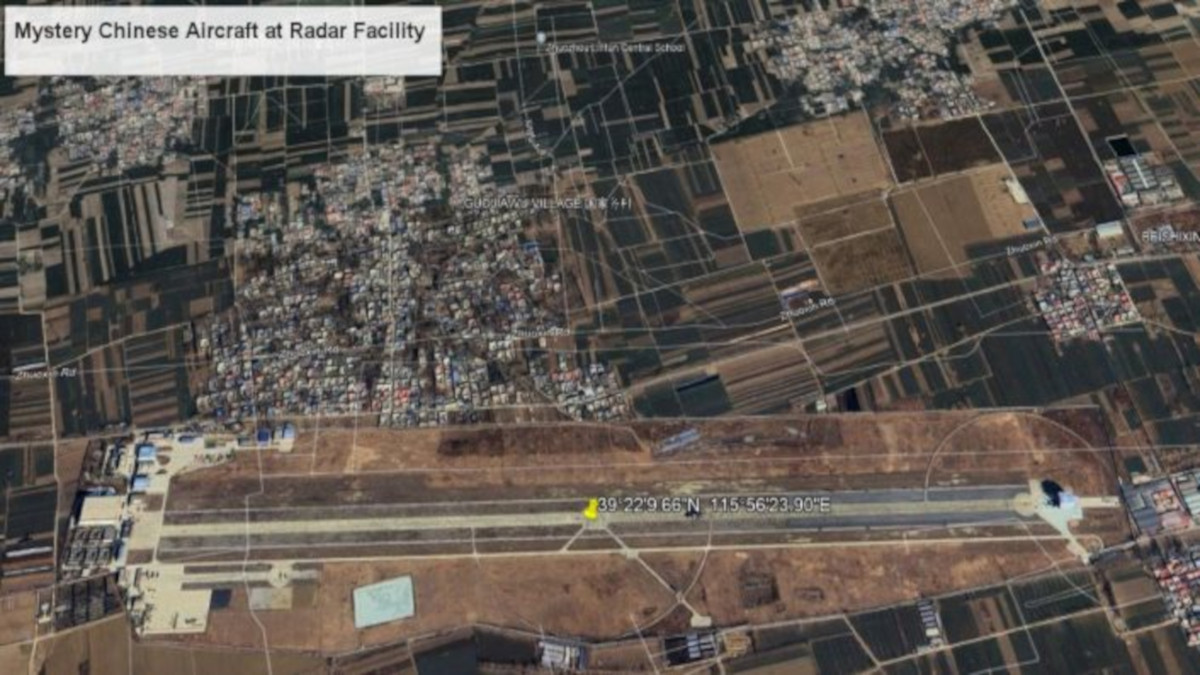Introduction: The Enigma of Baoding’s Flying-Wing
Earlier this year, satellite images revealed a mysterious flying-wing aircraft at a Chinese Radar Cross Section (RCS) test site in Baoding, Hebei province.
The aircraft’s unique appearance has led to widespread speculation among military analysts and aviation enthusiasts alike.
Is it a prototype of a new stealth drone or simply a model used for testing purposes?
The Aircraft: A Brief Overview
The mysterious aircraft seen in the satellite images resembles a flying-wing configuration.
Its shape and design are notably similar to the Northrop Grumman X-47B, an American UCAV (Unmanned Combat Aerial Vehicle) known for its stealth capabilities.
The Chinese aircraft, spotted at the eastern end of the runway near a hangar, has a cranked-kite wing design.
This suggests a focus on reducing radar visibility, a critical factor for stealth operations.
Interestingly, the aircraft lacks visible features for manned flight, such as a cockpit.
This absence hints the aircraft could be an unmanned aerial vehicle (UAV) or UCAV.
With a wingspan of approximately 55.64 feet, it falls within the size range typical of modern stealth drones.
Baoding RCS Test Site: A Hub for Stealth Testing
The Baoding facility has a history of testing stealth technologies.
It has previously been used to evaluate the radar cross-section characteristics of various Chinese aircraft, including the Hongdu GJ-11 Sharp Sword.
The presence of this new flying-wing model at Baoding indicates it might be undergoing similar evaluations.
These tests are crucial for validating the aircraft’s low observability (LO) and radar-absorbing materials, ensuring it can evade detection by enemy radar systems.
The facility itself is designed to support these tests. Equipped with rail-mounted hangars can slide over test articles, the site offers a level of protection from prying satellite eyes.
The test models are placed on pedestals, allowing radar systems to measure the object’s RCS from multiple angles.

An Airbus satellite image from February 2024 shows a flying-wing aircraft at the Baoding radar test facility in Hebei province, China. (Image credit: Google Earth)
Design Analysis: Similarities to the X-47B
Observers have noted the striking resemblance between the mysterious Chinese aircraft and Northrop Grumman’s X-47B. Both aircraft feature a blended-wing-body airframe and a cranked-kite wing configuration.
However, while the X-47B is tailless, the Chinese model appears to have two small canted vertical stabilizers towards the trailing edge.
This modification could indicate an effort to balance stability and stealth, as vertical stabilizers typically increase radar visibility.
Another intriguing aspect of the design is the absence of visible air inlets for engines.
It’s possible these inlets are located on the aircraft’s ventral side, hidden from view in the satellite images.
Alternatively, they might be omitted altogether on this test model, focusing solely on analyzing the shape’s radar cross-section.
Radar Cross Section Testing: The Heart of Stealth Technology
RCS testing is a vital step in developing stealth aircraft.
The Baoding facility’s layout suggests it’s well-equipped for such tasks. The aircraft can be mounted on pedestals, and multiple radar systems can analyze how electromagnetic waves interact with its surface.
This data helps engineers refine the aircraft’s shape and materials to minimize radar returns.
China has been investing heavily in stealth technology, with claims of developing radars capable of detecting stealth aircraft.
Testing at Baoding likely involves the aircraft’s stealth characteristics and the effectiveness of China’s radar systems in detecting these features.
GJ-11 Sharp Sword: The Predecessor
The GJ-11 Sharp Sword, developed by the Aviation Industry Corporation of China (AVIC), has already been tested at the Baoding facility.
It made its first public appearance during a military parade in October 2019, marking the 70th anniversary of the People’s Republic of China.
The GJ-11 is believed to be a significant step towards integrating UCAVs into China’s naval operations.
The Sharp Sword has been seen in unofficial photographs on mock-ups of Chinese aircraft carriers, suggesting a future role in carrier-based operations.
This development aligns with the Chinese Navy’s ambitions to enhance its capabilities with stealthy, unmanned aircraft capable of precision strikes and intelligence gathering.
Carrier-Capable UCAVs: A Strategic Asset
If the new flying-wing model at Baoding is indeed a prototype for a future UCAV, it could signal China’s intent to expand its naval aviation capabilities.
A carrier-capable UCAV would offer significant strategic advantages, including extended operational range, reduced risk to human pilots, and the ability to conduct prolonged surveillance and strike missions.
Observers like Rick Joe, a PLA expert, have suggested China’s carrier-based aviation might soon include flying-wing UCAVs.
The presence of such aircraft on carrier mock-ups indicates the PLA Navy is actively pursuing this technology.
Integrating UCAVs like the GJ-11 or its successor into carrier operations would enhance China’s power projection in contested maritime regions.
Stealth Technology: The Global Race
China’s pursuit of stealth technology is part of a broader global trend. Stealth aircraft, designed to evade detection, provide significant tactical advantages in modern warfare.
The United States, with its F-35 Lightning II and B-2 Spirit, has long been a leader in stealth technology. Russia has also entered the fray with its Su-57 stealth fighter.
The development of stealth drones adds another layer to this competition. Drones like the X-47B and Sharp Sword offer the potential for low-risk, high-impact missions, making them valuable assets in any military arsenal.
China’s focus on stealth UCAVs highlights its commitment to advancing its technological capabilities and maintaining a competitive edge.
The Role of Test Models: Experimentation and Validation
The use of test models at facilities like Baoding is standard practice in developing advanced aircraft.
By creating scale models or non-functional prototypes, engineers can experiment with different shapes and materials to find the optimal design.
These models allow for extensive testing without the high costs associated with full-scale prototypes.
It’s possible the mysterious flying-wing at Baoding is simply a test model used to study specific aspects of stealth design.
If true, this model may never become an operational aircraft. Instead, it could provide valuable data informs the development of future stealth drones.
Conclusion: Unraveling the Mystery
The appearance of the mysterious flying-wing aircraft at Baoding’s RCS test site has undoubtedly sparked interest and speculation.
Whether this aircraft represents a new phase in China’s UCAV development or is merely a test model remains unclear.
What is certain, however, is China continues to invest heavily in stealth technology and unmanned systems.
As more information emerges, the true nature of this aircraft will become clearer. For now, it serves as a reminder of the ongoing advancements in military technology and the continuous quest for an edge in the skies.
The Baoding mystery aircraft is a piece in a much larger puzzle, one involving the future of air combat and the balance of power on a global scale.
The Future of Chinese Stealth Drones
China’s ambition to enhance its military capabilities is evident in its pursuit of advanced stealth technology.
As the Baoding mystery aircraft continues to be a topic of intrigue, it underscores the importance of innovation and secrecy in modern warfare.
The world will be watching closely to see how China integrates these new technologies into its military strategy and what this means for the future of aerial combat.
The potential of a new, stealthy, carrier-capable UCAV could significantly alter the dynamics of naval warfare.
Whether this aircraft becomes a reality or remains a test model, it represents the cutting edge of aviation technology and the ongoing race to achieve air superiority.
The skies above Baoding may hold the key to the next generation of stealth warfare.


































